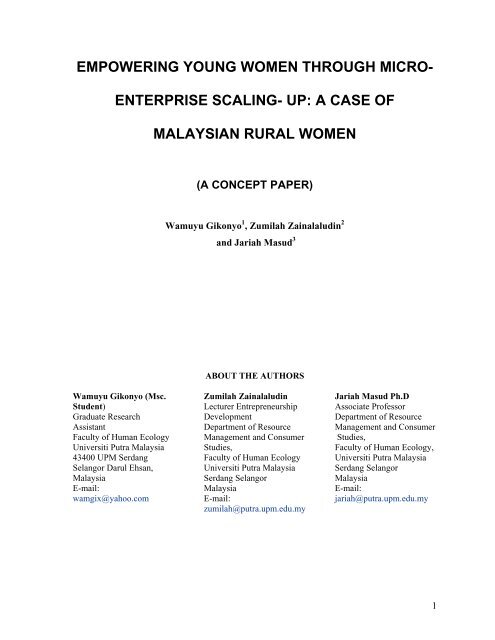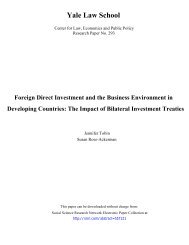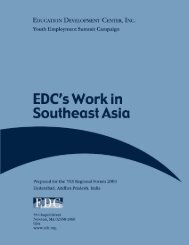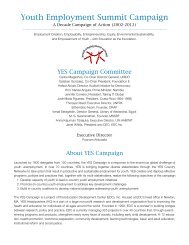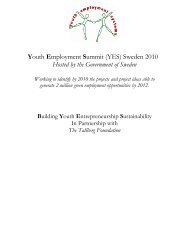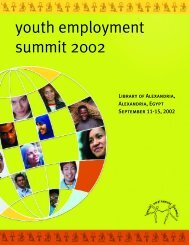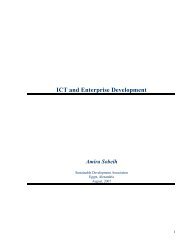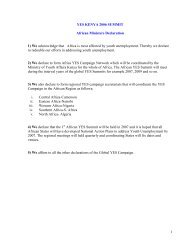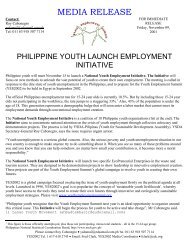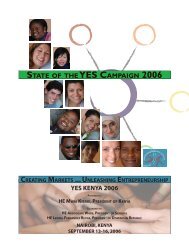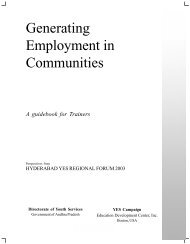Empowering Women Through Micro-Enterprise Scaling Up - Youth ...
Empowering Women Through Micro-Enterprise Scaling Up - Youth ...
Empowering Women Through Micro-Enterprise Scaling Up - Youth ...
You also want an ePaper? Increase the reach of your titles
YUMPU automatically turns print PDFs into web optimized ePapers that Google loves.
EMPOWERING YOUNG WOMEN THROUGH MICRO-<br />
ENTERPRISE SCALING- UP: A CASE OF<br />
MALAYSIAN RURAL WOMEN<br />
(A CONCEPT PAPER)<br />
Wamuyu Gikonyo 1 , Zumilah Zainalaludin 2<br />
and Jariah Masud 3<br />
ABOUT THE AUTHORS<br />
Wamuyu Gikonyo (Msc.<br />
Student)<br />
Graduate Research<br />
Assistant<br />
Faculty of Human Ecology<br />
Universiti Putra Malaysia<br />
43400 UPM Serdang<br />
Selangor Darul Ehsan,<br />
Malaysia<br />
E-mail:<br />
wamgix@yahoo.com<br />
Zumilah Zainalaludin<br />
Lecturer Entrepreneurship<br />
Development<br />
Department of Resource<br />
Management and Consumer<br />
Studies,<br />
Faculty of Human Ecology<br />
Universiti Putra Malaysia<br />
Serdang Selangor<br />
Malaysia<br />
E-mail:<br />
zumilah@putra.upm.edu.my<br />
Jariah Masud Ph.D<br />
Associate Professor<br />
Department of Resource<br />
Management and Consumer<br />
Studies,<br />
Faculty of Human Ecology,<br />
Universiti Putra Malaysia<br />
Serdang Selangor<br />
Malaysia<br />
E-mail:<br />
jariah@putra.upm.edu.my<br />
1
INTRODUCTION AND BACKGROUND<br />
Malaysia attained independence (from Britain) in August 1957. In its 46 years as a sovereign<br />
nation, great economic and social progress has been achieved. The population of Malaysia is<br />
multi-racial, comprised of Malays and other indigenous groups (63%), Chinese (24%)<br />
Indians (7%) and 1% “Others”, as well as over 5% of non-Malaysian citizens who mainly<br />
comprise immigrant labor (Rabieyah and Hajar, 2003). The country is moving fast from<br />
agricultural based to industrialization. Its economy is increasingly concentrated on the<br />
manufacturing and service sectors. The share of the agricultural sector has been decreasing<br />
over time. The agricultural sector which contributed 29percent in 1984 and 18.7 percent in<br />
1990, and was expected to further decline to 13.4 percent by the year 2000 (Malaysia,1991a<br />
in Aminah,1999).<br />
It cannot be denied that women have been involved in economic activities before the<br />
economists realized it. <strong>Women</strong> have been working in the informal sectors as well as in the<br />
formal sectors. Rural women comprise about one quarter of total Malaysian population and<br />
one third of agricultural labor force in the rural areas (Department of Statistics, 2003). As<br />
such, women play a very important role in poverty eradication and improving the level of<br />
living in Malaysia (Jariah and Laily, 1995). Their labor force participation increased from<br />
37.2 percent in 1970 to 46 percent in 1990 and 47.7 percent in 2003 (Department of<br />
Statistics, 2003). Young women especially among poor households have been actively<br />
involved in agricultural activities as unpaid family workers or farm help. This paper will seek<br />
to first discuss the various approaches that are used to explain entrepreneurship development<br />
among rural women (young women).<br />
Since the overall level of education attainment among rural women is low, their contribution<br />
is often limited to unskilled and manual work. An alternative measure is to encourage them<br />
to be involved in small business/ market production activities using existing skills that<br />
require small capital and basic skills (Jariah and Laily, 1995). Existing development<br />
programs which have been more of mass development have not addressed the special need of<br />
these women. To improve their level of living, special programs and approaches have to be<br />
designed to address their needs effectively. Lack of gender segregated data has been one of<br />
2
the constraints for planners to understand (the problems faced by rural young women) and<br />
design appropriate programs for this group of people. In an effort to eradicate poverty<br />
especially among the rural population, the government has and continues to carry out various<br />
development programs with special emphasis on women and entrepreneurship. This paper<br />
will also seek to share the Malaysian experience of empowering women to be economically<br />
independent.<br />
<strong>Women</strong> just like men have been involved in economic activities since early years. Their<br />
involvement has been in addition to their participation in the domestic sector. However, their<br />
economic activities have focused primarily on meeting basic needs, yet lack of resources and<br />
control of resources has been common. Their contribution in micro- entrepreneurship has<br />
been equally unpaid, unrecognized and undervalued. By <strong>Scaling</strong> up, women’s role in the<br />
economy will be enhanced. As a result of empowering women, there will be a development<br />
in the human capital whereby a continuity of the enterprises can be ensured since the young<br />
generation will be empowered.<br />
There is evidence that women’s projects have the potential to grow. Studies conducted in<br />
Malaysia indicated that about one third of projects have the potential to grow. <strong>Women</strong> also<br />
have the ability, and with proper guidance they can be successful. <strong>Micro</strong> Entrepreneurship<br />
makes significant contribution to the family, community and local economy. <strong>Micro</strong><br />
enterprise scaling up involves developing micro-enterprises into viable enterprises by making<br />
them formal. This involves: Moving the enterprise unit from informal to formal by<br />
registration of the business entity, having an <strong>Enterprise</strong>/ business plan that is sustainable and<br />
viable, Taking into consideration several factors- Quality control, health issues, legal<br />
requirements, Managerial aspects and record keeping, Human resource development and<br />
management.<br />
As a back bone to the empowerment of women through micro-entrepreneurship scaling-up,<br />
issues of human capital development, succession of enterprise and continuity of the<br />
enterprise are crucial. Human capital development comes with increased managerial<br />
responsibilities, as the women can be able to take on more roles in the running of the<br />
3
enterprise. Continuity of the enterprise is also ensured as the second generation is**. There is<br />
also the training of young women, this helps to ensure that succession takes place smoothly<br />
and successfully. The main aim of this paper is to address two objectives:<br />
i) To discuss the approaches used to explain micro enterprise scaling- up among<br />
rural women as well as young women.<br />
ii) To share the Malaysian experience of empowering women to be economically<br />
independent through micro-enterprise scaling up.<br />
4
Approaches Used To Discuss Entrepreneurship<br />
Three approaches were popularly used in the past to discuss entrepreneurship, women<br />
entrepreneurs and their involvement in enterprise development. There are two new<br />
approaches that have been the focus of researchers recently especially in discussing women<br />
entrepreneurs. Macro perspectives are tailored to impact rural enterprises on the national<br />
economy development or rural economic development as well as mitigate poverty. <strong>Micro</strong><br />
perspectives are more towards the quality of life of rural women, family, and increment in<br />
household income as well as rural enterprise development issues.<br />
Both micro and macro perspectives have several related theories to explain the scenario of<br />
the enterprise as well as the entrepreneur’s development from a micro perspective. The first<br />
three approaches as shown in Figure 1 are (1) sociology; (2) economy; and (3) psychology<br />
(Ab. Aziz et al., 2005; Bruni et al., 2004; Nearchou-Ellinous & S.Kountouris, 2004; Beaver,<br />
2002; Burns, 2001; Zimmerer & Scarborough,1998); and the other two approaches are; (1)<br />
business management and; (2) gender (Ab.Aziz, 2005 and Bruni, 2004).<br />
Figure 1<br />
Old and New Theories in the issue of Rural <strong>Women</strong> Involvement in <strong>Enterprise</strong><br />
Development<br />
Economy<br />
Business<br />
Management<br />
Sociology<br />
The involvement of rural<br />
women in the<br />
development of<br />
enterprise<br />
Gender<br />
Psychology<br />
OLD APPROACHES<br />
NEW APPROACHES<br />
5
Economy<br />
Most of the approaches explaining entrepreneurship and enterprise development start from an<br />
economist point of view (Bruni et al., 2004) because entrepreneurs bring changes to<br />
economic development (Ab. Aziz et al, 2005, p.9). The discipline of economy explains the<br />
entrepreneurship as a capacity of innovation (Ogbor, 2000; Collin & More, 1964; Cole, 1959;<br />
Schumpeter, 1939; and Knight, 1921). Economists are different from capitalist who supply<br />
capital and manipulate other parties involved (Cantillon in Hisrich & Peter, 1998). For this<br />
reason, entrepreneurship refers to the rural women who are running the enterprise using their<br />
own ideas and developing their products. In order for the enterprise to succeed, the<br />
entrepreneurs should be continuously innovative. An example of related theories in economic<br />
approach are Knight’s Theory of Risk (Knight, 1921), Schumpeterian Theories (Schumpeter,<br />
1939) and Cole’s Theory of <strong>Enterprise</strong> Creation as cited in Bruni (2004). These are termed as<br />
the as the major foundations in entrepreneurship development.<br />
For scaling up rural women’s enterprises, Supply and Demand Theory in the economic<br />
approach have underlined the high potential for the rural enterprise production. This can<br />
promote the enterprise to scale up. However after one level this micro enterprise fails to grow<br />
even though there is high demand for the production. This phenomenon may be explained by<br />
the Theory of Labor in economy, where the entrepreneur is the inventor herself and the<br />
enterprise starts with her own ideas and innovations. In order for the enterprise to develop,<br />
the entrepreneur has to play a vital role in being innovative. If they die, the enterprise will<br />
also die and be closed down (Dollinger, 1995). Most of the economic approaches mainly<br />
focus on macro issues of rural enterprise development; for example the role of micro<br />
businesses in rural economic development as well as the national economic growth. Little has<br />
been addressed and its important to empower the entrepreneurs (rural women) in order to<br />
sustain the growth as well as scaling up the enterprise.<br />
Sociology<br />
The three theoretical paradigms in sociology are structural-functional or functionalism,<br />
social-conflict and social-interaction (Lindsey, 1990). Entrepreneurship is more towards the<br />
6
interaction of members of society and their day-to-day fulfillment of needs in their life (Bruni<br />
et al, 2004). Economic and gender approaches are actually part of social approach. Some<br />
literature addresses the importance of religious belief, which is part of socio-culture in<br />
explaining the development of entrepreneurship (Ab. Aziz et al., 2005, p.11). For example,<br />
Weber (1930) observed that the religious spirit of the Protestant followers has influenced<br />
theirs success in economic ventures.<br />
There is also an entrepreneurship model called the social development model introduced by<br />
Gibbs (1972). This explained the process each person would go through to bring changes<br />
through business activities. However, the difference in group success (between women and<br />
men) is a result of group differences in culture, norm and value (Light, 1979, as cited in<br />
Smith-Hunter & L. Boyd, 2004) In addition, culture is one of the barriers for women to<br />
succeed in their economic activities (Cassell, 1997). As Weber (1930) found in his Theory of<br />
Labour, those who are excluded from the main stream economy (mostly women) will often<br />
turn to self-employment and involvement in entrepreneurship activities.<br />
As for Malaysian rural women, their enterprises are mostly started as a social group activity,<br />
which is founded under a government program. They work together with each other and<br />
pool ideas in venturing into a business. However, this approach is not sustained and can not<br />
be developed further to become a business due to so many conflicts during the process of<br />
running and managing the enterprise (Maimunah, 2001; Jariah et al., 2003; and Jariah &<br />
Laily, 1995). Therefore, they have to run the business individually, with family or less<br />
number of partner as a proper business set-up in order to develop and scale up. The skill of<br />
interaction with partners, family members, workers, members of society and other related<br />
parties are still essential for the success of the business.<br />
Psychology<br />
The Psychological discipline stresses the importance of individual characteristics of<br />
entrepreneurs such as risk taker, natural tendency to be competitive, ability to work<br />
constantly and geographical mobility (Fournier & Grey, 1999). Rural women entrepreneurs,<br />
must have relevant characteristic as entrepreneurs in order to succeed in running the<br />
7
enterprise. Nevertheless, for the enterprise to develop, these women should also posses some<br />
additional characteristic underlined by Business Theory. As Weber’s Theory of Labor (1930)<br />
concedes, entrepreneurs are those who have special characteristics to work independently and<br />
be their own boss.<br />
Besides the personal traits, psychological approach also underlines a lot of motivation<br />
theories to explain the phenomenon of successful entrepreneurs such as Maslow Theory of<br />
Needs, Theory X and Y by Mc Gregor, Theory Z by Ouchi and Theory of Two Factors by<br />
Herzberg as cited in Zumilah (1998); Boone & Kurtz (1996); and Skinner & Ivancevich<br />
(1992). Internal motivation is one of the powerful intrinsic values for the entrepreneurs to<br />
succeed in developing their enterprise.<br />
Some rural women venture into the enterprise by following other people without having their<br />
own need and desire to be an entrepreneur. They just want to socialize with other members in<br />
the society or as a hobby in their free time (Maimunah, 2001; and Jariah & Laily, 1995).<br />
<strong>Women</strong> with potential to develop their enterprise are those who possess high level of<br />
motivation and entrepreneurial traits of a businessman (Still & Timms, 1999, 2000; and Cliff,<br />
1998). Furthermore women value family more than wealth (Demartino & Barbato, n.d).<br />
Business Management<br />
Business Management has eight major fields: management, production, marketing, financial<br />
management, risk management, human resource management, corporate communication and<br />
industrial relation (Zumilah, 1998; Boone, L.E. & Kurtz, D.L., 1996; and Sinner &<br />
Ivancevich, 1992). Some of the factors such as industrial relations and corporate<br />
communication (but not social networking) do not directly influence micro enterprise<br />
development. However, skill in management, production, marketing, financial management<br />
and social networking are crucial (Bradley & Sauders, 1987). Each of these fields can be a<br />
single approach used in explaining the development of rural women’s enterprises from a<br />
micro level perspective.<br />
8
Business Theory by Drucker (2003) underlined a theory of business which has three parts:<br />
(1) there are assumptions about the environment of the organization; (2) assumptions about<br />
specific missions of the organization; and (3) assumptions about the core competencies<br />
needed to accomplish the organization’s mission.<br />
For rural women, enterprises exclude the assumed environment; the characteristic of the<br />
organization is actually the characteristic of the entrepreneurs. Thus, the second and third<br />
elements are additional characteristics of the entrepreneurs.<br />
Therefore, women who run the enterprise should have a good vision because personal goals<br />
appear to have more dominant influence than business goals (Still & Timms, 2000, 1999; and<br />
Cliff, 1998) and relevant competencies, especially in management, production, marketing,<br />
social networking and financial management for their enterprise development. However,<br />
rural women are mostly less educated and do not have prior work experience as part of<br />
important characteristic to develop competencies, and these could be an obstacle to to scale<br />
up the enterprise (Nearchou-Ellinas & Kountouris, 2004; and Bowen & Hisrich, 1986).<br />
Bowen & Hisrich findings were in-line with the above findings or even worse for the case of<br />
Malaysian rural women in micro enterprise. This is because most of them have poor formal<br />
education background and no prior working experience at all in running their micro<br />
enterprise (Askiah, 2002, Maimunah, 2001; and Jariah & Laily, 2005).<br />
Gender<br />
Gender is actually a sociological component; a social construction of what is masculinity and<br />
femininity (Lindsey, 1990) and entrepreneurship according to Bruni et al. (2000) as cited in<br />
Bruni (2004) is known as masculine activity (the entrepreneur as a conquer of unexplored<br />
territories, the lonely hero, the patriarch). There are two main groups of gender theories: nonfeminist<br />
and feminist, as listed in Table 1 below. Recently, gender is one of an important<br />
approach to understand issues and problems related to women, as well as women’s<br />
entrepreneurship issues.<br />
9
Table 1<br />
Non-feminist and Feminist Theories of Gender<br />
Non-feminist<br />
1. Theories of God and Nature:<br />
a) Religious Theories<br />
b) Biological Nature Theories<br />
2. “Sex War” theories<br />
a) Theories by Sigmund Freud (Penis Envy<br />
and Womb Envy)<br />
b) Dominance rooted in sexual antagonism.<br />
c) Maintaining dominance through violence<br />
d) Theory of selfish gene<br />
1. Liberal Feminism<br />
Feminist<br />
a) Patriarchy Theory by Filmer<br />
b) Feminist Liberalism by Wollstonecraft<br />
(1972) and Locke ( ) against Filmer<br />
2. Feminist Socialism<br />
a) Marx Theory<br />
b) Engels Theory<br />
3. Radical Feminist<br />
- critique of heterosexuality is a centre of<br />
theory<br />
- concern with patriarchy<br />
- reject all ‘male’ values<br />
Source: 1. Lindsey, L. (1990). Gender Roles: A Sociological Perspective. New Jersey: Prentice Hall, p.10-12;<br />
2. Bruni, A., Gherardi, S., & Poggio, B. (2004). Doing Gender, Doing Entrepreneurship: An<br />
Ethnographic Account of Intertwined Practices. Gender, Work and Organization, 11(4), 406-429<br />
3. Gender and Gender Roles (n.d). Retrieved July 26 th , 2004 from<br />
http://faculty.washingtopn.edu/ktupper/w200w3.html.<br />
As found by Barret (1995), Meredith & Barret, (1994) and Peacock (1994) as cited in M.J.<br />
Stanger (2004), there are no significant difference in the source of assistance used by men<br />
and women but yet women enterprises face a higher failure rate than men’s. According to<br />
Barret as cited in M.J. Stanger (2004), men are significantly more likely to have access to<br />
several outside resources of business learning and women’s roles and responsibilities become<br />
imbued with the ideal of the domestic, leisure and private sphere (Barker & Chalus, 1997;<br />
Still & Timms, 2000). Consequently, they do not want to develop their business further<br />
(Nearchou-Ellinas & Kountouris, 2004).<br />
Therefore, the use of gender theories to understand the issues and problems in rural women’s<br />
enterprise scaling up become essential to figure out what actually causes the poor<br />
development as well as the development of women enterprise (Still & Timms, 2000). Using<br />
gender theories tackles both macro level (especially policy development for women<br />
10
enterprise development) and micro level; for example: gender awareness among family<br />
members or at society level and the women themselves.<br />
The Malaysian Experience of <strong>Empowering</strong> <strong>Women</strong> through <strong>Micro</strong>- <strong>Enterprise</strong> <strong>Scaling</strong>-<br />
<strong>Up</strong><br />
This section will seek to highlight rural women’s contribution in the entrepreneurship<br />
domains. <strong>Women</strong>’s involvement in enterprise development is a global issue. This is because<br />
it is important for economic growth and is a growing phenomenon all over the globe<br />
(Nearchou-Ellinous & S.Kountouris, 2004; and Asian Development Bank, 1997). Rural<br />
women’s involvement in the economic development of the family and society at large is also<br />
a crucial issue that needs to be addressed properly in view of the fact that the contribution is<br />
significant especially in poverty eradication (ILO, 2003; Jariah et al., 2003; Maimunah, 2001;<br />
Jariah & Laily, 1995; and Laily & Jariah, 1996). Their enterprise is always micro in size<br />
(Maimunah, 2001; and Jariah & Laily, 1995) with workers less then 5 (Maimunah, 2001;<br />
Still & Timms, 2000) and operating in a rural area- an area with population less then 10,000<br />
and outside the governance of local authority (Malaysian Department of Statistic, 1996).<br />
Malaysian Second Rural Development Transformation was initiated to modernize rural areas<br />
and make them comfortable for living in 1995 (Seventh Malaysian Plan, 1996). This policy<br />
emphasized on the empowerment of communities to bring about changes in rural areas. One<br />
of the methods was through income generating activities by empowering the people<br />
especially women. Even though there is poverty in urban areas, poverty in rural areas is more<br />
significant in terms of percentages. Households headed by the elderly (those aged 65 and<br />
above) experience the highest incidence of poverty at 22.7%, followed by female-headed<br />
households (16.9%). By economic division of labor, agriculture workers have the highest<br />
incidence of poverty at 16.4% (Eight Malaysian Plan, 2001). In Malaysia poverty<br />
eradication through income generating activities is almost 50 years old since independence.<br />
However, the scaling up of micro enterprises remains a crucial issue.<br />
The history of micro enterprise development in Malaysia can be traced from the early stages<br />
of economic development. The home economics program was introduced among women<br />
11
especially rural women to help them manage and run the family effectively and efficiently.<br />
Training Courses were conducted to increase women’s skills in managing their households.<br />
As the country developed, the need to increase income motivated some women to venture<br />
into income generating activities.<br />
Worldwide, micro enterprise coupled with micro credit is considered as one of the most<br />
effective measures to overcome poverty and improve the living standards of the rural and<br />
agricultural population (Jariah, Zumilah, Laily, Sharifah and Mohamed, 2003). Amanah<br />
Ikhtiar Malaysia through its micro credit program has enabled more than 60,000 poor women<br />
to venture into income generating activities. Since the beginning of the program, more and<br />
more women have been able to scale up their income generating projects to micro-enterprises<br />
and small- scale enterprises.<br />
A recent study, Jariah et al. (2001) revealed that micro enterprise projects initiated under the<br />
Rural <strong>Women</strong>’s Extension Group (KPW) are run by both husband and wife. These<br />
enterprises are also the main source of income for the majority of families under these<br />
projects. Though the earnings from micro enterprises cannot be compared to earnings of<br />
large scale industries, micro enterprises make significant contributions to development,<br />
especially of rural communities. In addition to increased household income, micro<br />
enterprises also contribute to creating employment opportunities to the rural population<br />
particularly young rural women. A study conducted in 2000 among 105 women micro<br />
entrepreneurs through out peninsular Malaysia showed that these entrepreneurs hired on<br />
average seven persons and the bulk of workers hired were women (Jariah et al., 2001).<br />
<strong>Scaling</strong> up of micro enterprises can be used as a means to accelerate economic development<br />
of rural women. Since women have been traditionally involved in micro enterprises, it is<br />
logical to focus micro enterprise development on young women to ensure sustainability.<br />
The <strong>Scaling</strong>-up Model<br />
<strong>Micro</strong> <strong>Enterprise</strong>s can be classified as: New enterprises in the start up phase (high turnover),<br />
Existing enterprises that have not grown, Existing enterprises that have shown small growth,<br />
12
enterprises that have graduated with ten or more workers, Generally they can be classified as:<br />
Livelihood enterprises and Growth oriented enterprises<br />
The model explains the Development of survival enterprises into viable entities through<br />
scaling-up efforts. Development takes place within each of the four stages (whereby change<br />
is the fundamental nature of development) while scaling-up involves change in size and<br />
formalizing of the enterprise. Development and growth of enterprises moves towards the<br />
involvement of family members. This then results in a Gradual shift of enterprise orientation<br />
to family business/enterprise. Efforts to develop family businesses into community enterprise<br />
can then be realized.<br />
<strong>Women</strong> Entrepreneurial Development<br />
Survival<br />
Income<br />
Generating<br />
Program<br />
<strong>Micro</strong><br />
enterprise<br />
Self<br />
Employed<br />
Program<br />
Poor<br />
Small<br />
<strong>Enterprise</strong><br />
<strong>Women</strong>/family<br />
Entrepreneurial<br />
Program<br />
Low Income<br />
Group<br />
Community<br />
<strong>Enterprise</strong><br />
High Middle<br />
Income<br />
Middle Income<br />
Group<br />
The <strong>Scaling</strong>-up Components<br />
These include: Financial services: Credit facilities critical in capital intensive activities, Non<br />
financial services, a Sub-sector approach. <strong>Micro</strong> Credit Programs target the poor groups.<br />
They are also operated in different forms: NGO’s, credit cooperatives, credit unions or<br />
banks. Grameen Banks or Grameen type lending, BRAC (Bangladesh), Lembaga Dana<br />
Kredit Perdesaans (LKDP) Indonesia, Vietnam Bank for the Poor, The Rural Self-Reliance<br />
13
Fund (Nepal), Amanah Ikhtiar (Malaysia). Non financial Input includes: Design, Product<br />
Development, Market information, Marketing information, appropriate technology, Skills<br />
training in business and entrepreneur development<br />
14
CONCLUSION<br />
Rural women are active participants contributing in economic well- being of the family as<br />
well as the nation. In the future, these women can be expected to play more active roles in<br />
micro entrepreneurship scaling-up. <strong>Empowering</strong> a young woman through scaling up her<br />
enterprise entails a clear understanding of the dynamics of women’s enterprises. To design a<br />
right framework to promote the empowerment of women in policy development; a change of<br />
attitude as well as culture among rural dwellers must be put into perspective. There is no<br />
single theory to understand the dynamics of rural women entrepreneurs. Therefore, several<br />
theories have to be put into a framework. This is a great and heavy duty to come up with a<br />
model of scaling up of rural women’s enterprises. However, ignoring this issue would be a<br />
huge waste to women’s micro enterprise potentials, besides the importance of empowering<br />
rural women to become economically independent.<br />
Young women have the potential to contribute significantly to improving quality of life of<br />
rural families’. Nevertheless, Gender sensitive policies and programs are a prerequisite to the<br />
scaling up efforts while political will and commitment from all parties is equally of<br />
importance. <strong>Scaling</strong>-up aims to increase productivity and efficiency. At the same time, the<br />
role of young rural women in the economy is enhanced as well as human capital<br />
development. Human capital development comes with increased managerial responsibilities,<br />
as the women can be able to take on more roles in the running of the enterprise.<br />
By empowering young entrepreneurs, succession (progression) of the enterprise is ensured.<br />
This involves women entrepreneurs acting as mentors who pass on the skills to the young<br />
persons that will help them to sustain the enterprise through the generations. Encouraging the<br />
second generation of young women to be involved in micro-enterprise scaling up results in<br />
continuity of women’s enterprises as well. <strong>Micro</strong>- enterprise scaling- up results in <strong>Women</strong>’s<br />
empowerment as the women gain control and ownership of the enterprise. Empowerment<br />
programs result in various things for women. These include: Physical mobility, Economic<br />
security/control over resources/ independence, Ability to make various decisions on her own,<br />
Freedom from domination, Political and legal awareness, Involvement in community<br />
activities, and Access to information as well as training.<br />
15
REFERENCES<br />
Ab. Aziz, Y., Perumal, S., Faizuniah, P. (2005). Principles of Entrepreneurship. Petaling<br />
Jaya: Prentice Hall<br />
Asian Development Bank (1997). <strong>Micro</strong> <strong>Enterprise</strong> Development: Not by Credit Alone.<br />
Barker, H. & Chalus, E. eds (1997). Gender in Eighteenth-Century Englan: Roles,<br />
Representation and Responsibilities. London: Longman.<br />
Beaver, G. (2002) small Business, Entrepreneurship and <strong>Enterprise</strong> Development. London:<br />
Prentice Hall.<br />
Boone, L.E. &Kurtz, D.L. (1996). Contemporary Business: Eight Edition. New York: Dryen<br />
Press.<br />
Bowen, D. & Hisrich, R. (1986). The Female Entrepreneur: A Career Development<br />
Perspective”. Academy of Management Review, April, 392-407.<br />
Bradley, D.B. & Saunders, H.L. (1987). Problems <strong>Women</strong> Face in Entrepreneurial<br />
Development. Annual Conference Proceedings of Small Business Institute Director’s<br />
Association.<br />
Bruni, A., Gherardi, S., & Poggio, B. (2004). Doing Gender, Doing Entrepreneurship: An<br />
Ethnographic Account of Intertwined Practices. Gender, Work and Organization,<br />
11(4), 406-429<br />
Cassell, C. (1997). The Business Case for Equal Opportunities: Implication for <strong>Women</strong> in<br />
Management. <strong>Women</strong> in Management Review, 12(1), 11-16.<br />
Cliff, J.E (1998). “Does one size fit all”- Exploring the Relationship Between Attitudes<br />
towards Growth, Gender and Business Size. Journal of Business Venturing, 13(6),<br />
523-542.<br />
Cole, P.M. (2000). Understanding Family Business Relationship: Preserving the Family in<br />
the Business. The Family Journal: Counselling and Therapy for Couples and<br />
Families, 8(4), 351-359.<br />
Demartino, A & Barbato, R. (n.d). Gender Differences Among MBA Entrepreneurs.<br />
Department of Statistic. (1996). Vital Statistic, 1996 Report.<br />
Fournier, V. & Grey, C. (1999). “Too much too little and too often: a critique of Du-Gay’s<br />
analysis of enterprise”. Organization, 6(1), 107-128.<br />
Gender and Gender Roles (n.d). Retrieved July 26 th , 2004 from<br />
http://faculty.washingtopn.edu/ktupper/w200w3.html.<br />
Gibs, J. (1972). “ Issues in Defining deviant Behaviour” in Theoretical Perspective on<br />
Deviance, edited by Scott, R.A. & Douglas, J.D. New York: basic Books.<br />
International Labour Organisation – ILO (2003). Gender Issues in <strong>Micro</strong>-<strong>Enterprise</strong><br />
Development. Retrieved January 16th 2003, from<br />
http://www.ilo.org/public/english/bureau/gender/business/ent/index.htm<br />
Jariah, M. & Laily, P. (1995). Project Oriented Research: Enhancing the Economic<br />
Contribution of Poor Rural <strong>Women</strong>. A Report Submitted to Japan International<br />
Cooperation Agency (JICA).<br />
Jariah, M., Laily, P., Mumtazah, O. & Aini, S. (2003). Report on Mechanization &<br />
Technological Adoption: <strong>Scaling</strong> up <strong>Micro</strong> enterprises To Small Scale <strong>Enterprise</strong>s.<br />
Monograph Series on Social Science. Serdang: Penerbit Universiti Putra Malaysia.<br />
Laily, P. & Jariah, M.(1996). Profile of Successful Woman in <strong>Micro</strong> <strong>Enterprise</strong>. A Report<br />
Submitted to Japan International Cooperation Agency (JICA).<br />
Lindsey, L. (1990). Gender Roles: A Sociological Perspective. New Jersey: Prentice Hall.<br />
16
Maimunah, I. (2001). Malaysian <strong>Women</strong> in Rural Development and Entrepreneurship: From<br />
Rural Producers to Urban Entrepreneurs. London: ASEAN Academic Press.<br />
Smith-Hunter, A. & L.Boyd, R. (2004). Applying Theories of Entrepreneurship to a<br />
Comparative Analysis of White and Minority <strong>Women</strong> Business Owners. <strong>Women</strong> in<br />
Management Review, 19(1), 18-28.<br />
Still, L.V. & Timms, W.(2000). <strong>Women</strong>’s Business: The Flexible Alternative Work Style for<br />
<strong>Women</strong>. <strong>Women</strong> in Management Review, 15(5-6), 272-282.<br />
Still, L.V. & Timms, W.(1999). “ Small business in Western Australia: A Comparative<br />
gender study”. Proceeding of 1999 World Conference on International<br />
Entrepreneurship, Singapore, August, 725-733.<br />
Weber, M. (1930). The Protestant Ethic and the Spirit of Capitalism. London: Routledge.<br />
Zimmerer, T.W. & Scarborough, N.M. (1998). Essentials of Entrepreneurship and Small<br />
Business Management: Second Edition. London: Prentice Hall.<br />
Zumilah, Z. (1998). Pengenalan Kepada Perniagaan. Penerbit Elman Sdn Bhd: Kuala<br />
Lumpur.<br />
17


